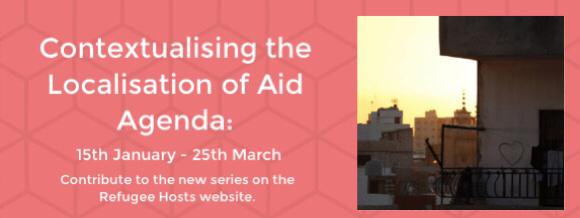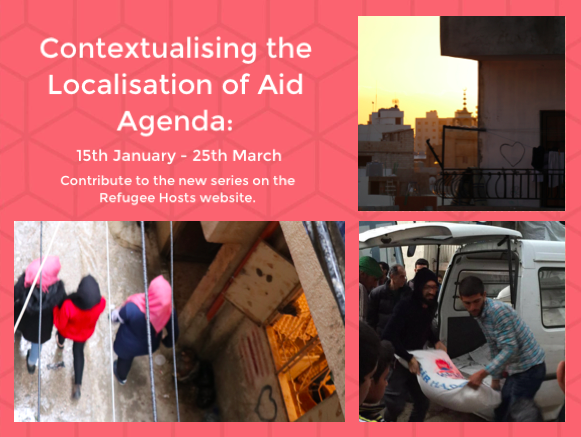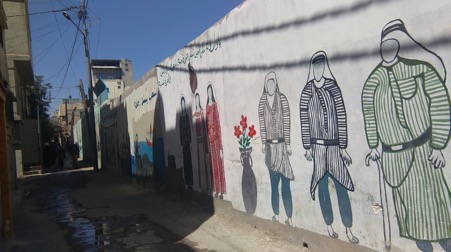
READ THE SERIES HERE.
Local Communities and Contextualising the Localisation of Aid Agenda
Series Introduction by Dr Elena Fiddian-Qasmiyeh, Refugee Hosts PI and UCL
In recent years, and especially since the 2016 World Humanitarian Summit, the ‘localisation of aid agenda’ has become prominent in discussions about responses to displacement. This agenda starts by recognising that ‘local actors’ play key roles in responding to displacement and other humanitarian situations; it subsequently aims to shift resources from ‘international actors’ – including UN agencies, donor states, and international NGOs – to ‘local actors’ and to develop modes of partnership and co-working that go beyond ‘subcontracting’ local actors to work on ‘international’ programmes. The ‘localisation of aid agenda’ therefore attempts to bring local-level responses to displacement into the nexus of international humanitarianism by developing policies and strategies that engage effectively (and efficiently) with local actors.
Against this backdrop, our new Refugee Hosts blog series aims to critically examine and contextualise the ‘localisation’ agenda from diverse angles and through a range of disciplinary perspectives. We do so by building upon the conversations we have already been developing as part of our project, including vis-a-vis conceptualisations of the location, value and nature of ‘the local’ itself.

‘Localising’ the Localisation of Aid Agenda: Who, when, where?
In practice, the ‘localisation of aid agenda’ often equates ‘the local’ with actors situated within and representing a specific geopolitical region (ie. a regional organisation such as the Arab League), actors operating at the national level (i.e. host states such as Lebanon, Jordan or Turkey) and/or on the sub-national level (including municipal authorities).
While these scales are often referred to interchangeably through the term ‘local’ in the localisation policy discourse, actors on the micro-level (including residents of towns, cities and camps for instance) are often primarily (or even exclusively) visible as populations affected by displacement: they are represented as individuals and communities which need regional, national and municipal-level actors to implement appropriate policies and programmes to provide services and/or mitigate tensions, rather than being acknowledged ‘as’ local actors responding to displacement themselves.
However, studies from around the world (including pieces published on Refugee Hosts) are prompting an increased recognition that local people and communities – including local volunteers and members of local faith communities – are often, if not always, the first providers of assistance in contexts of displacement.
In line with these studies, in our research project (whose full title is ‘Examining Local Community Experiences of and Responses to Displacement from Syria’) we are particularly interested in further ‘localising’ the ‘localisation’ debate: we aim to develop a better understanding of how, why and with what effect diverse ‘local communities’ at the level of neighbourhoods have (or have not) responded to the arrival and everyday presence of refugees from Syria.
However, this requires us to continue exploring: ‘what’ or ‘who’ is the local; ‘where’ and ‘when’ is the local; what, if any, is the relationship between different ‘levels’ and ‘scales’ of response across time and space; and how are different local actors (including local communities implicitly or explicitly motivated by faith) perceived, engaged with, or rejected by a range of local, sub-national, national, regional and international actors?
Being and belonging to ‘the local’?
As our project aims to highlight, on an empirical level ‘local host communities’ are not only composed of citizens, but also refugees and displaced peoples: we start from the recognition that newly displaced populations do not only share spaces with or aim to integrate into ‘local’ communities of ‘nationals’, but also into communities that include or have been formed by ‘established’ or ‘former’ refugees/IDPs of similar or different nationality/ethnic groups (i.e. see here, here, and here). In turn, in spite of typically being represented by humanitarian narratives as passive victims, we start by acknowledging that displaced people are themselves key providers of aid, including through processes that I refer to elsewhere as ‘refugee-refugee humanitarianism.’
However, in spite of the long-standing ’empirical’ presence of refugees in and as local communities in Lebanon, Jordan and Turkey, it is equally the case that refugees and IDPs may not be ‘perceived’, represented or accepted ‘as’ local by citizen-residents, governments or (inter)national organisations.
This leads to a question we are exploring through our project, and also through this blog series: Who is identified and accepted by different people as a member of a ‘local’ community, and who is excluded from this category, for instance being labelled as ‘just’ temporary sojourners who do not ‘truly belong’ to ‘the local’ level?
Indeed, in line with Refugee Hosts’ Co-Is Dr Anna Rowlands’ and Prof Lyndsey Stonebridge’s earlier contributions (here and here), we ask: how and when is ‘the local’ formed, and how do ‘the local’ and forms of ‘political community’ change over time and space?
Following on from this, and in relation to the localisation of aid agenda: What are the implications of diverse processes – political, discursive, representational – of including and excluding different people, communities, organisations and indeed spaces from the category of ‘the local’?

Perceptions and representations of local responses: efficient or exclusionary?
With such diverse actors responding, or not responding, to displacement on ‘local’ levels, related questions arise relating to how local responses are perceived, evaluated, negotiated and resisted by different stakeholders, including people affected by displacement.
Indeed, the relative informality and spontaneity of many local responses – in contrast to the more bureaucratised and professionalised nature of international humanitarian responses – has emerged in diverse pieces written for Refugee Hosts over the past few months; these pieces have highlighted both the opportunities of such informal responses, and also the challenges of these.
For example, Dina Zbeidy’s research with refugee women in Jordan highlights how local communities of support can often arise from shared experiences – in this instance, of shared widowhood – creating feelings of solidarity and dignity that are spontaneous and informal in nature.
Furthermore, as Eva Svoboda notes here, ‘local’ organisations often have greater access to and understanding of the needs of conflict-affected populations since they are already ‘on the ground’ at the outbreak of a crisis; they are well-situated to adapt to diverse challenging, and dangerous, circumstances precisely because they have strong networks and “a deeper understanding of the local context than international counterparts“.
In recognition of these and other advantages, international stakeholders are increasingly committing to working with ‘national’ organisations and sharing financial resources with ‘local partners’. However, there is a need both to question the terms of this engagement (which still often amount to co-opting local actors to fulfil international agendas), and to acknowledge that official support for ‘local’ actors may simultaneously be characterised by implicit and explicit forms of mistrust.
For instance, international stakeholders have often expressed concerns that local responses may be motivated by politics and ideology rather than ‘humanitarian’ impulses and principles; concurrently, international actors have often assumed that ‘local’ responses are more ‘exclusionary’ and ‘biased’ than ‘formal’ (read ‘secular international’) humanitarian responses. As I have argued elsewhere (including here), these concerns are often intimately related to beliefs about the relationship between religion and gender.
In essence, international stakeholders often express concerns that ‘local’ responses (in particular those motivated or inspired by faith) will exclude and/or discriminate against women, girls and LGBT refugees, while (secular) international responses are (implicitly or explicitly) assumed to be ‘better’ at including these and other social groups, and at promoting gender equality, female empowerment and LGBT rights.
There are by now, of course, extensive critiques of the assumption that ‘international’ humanitarian agencies are ‘neutral’, ‘apolitical’ or ‘gender-equal’ (including here), and yet these assumptions about the biases and inequalities perpetuated by local level actors continue to exert influence on the way that partnerships are (or are not) developed between different international and ‘local’ actors.
On the one hand, when analysing local responses – including local level hospitality by established refugee communities – it is of course essential that detailed attention is given to local processes of exclusion and hostility. This is to develop a notion of the ‘local’ and of the ‘community’ that recognises the diverse motivations that encourage members of local communities to respond to refugees, as well as the processes of marginalisation, exclusion and precarity that can and do frame the everyday lives of people affected by displacement.
On the other hand, it also means critically exploring which local actors are supported and viewed as ‘good partners’, which local actors are viewed with suspicion, and why.
Ultimately, it means that critical analysis is necessary to understand (and to take steps to overcome) the diverse forms of prejudice, exclusion, discrimination and structural inequalities that exist within and across all levels and forms of response to displacement: international, local and everything between.
Contextualising the Localisation of Aid Agenda
In all, the Refugee Hosts research project aims to contribute to the ‘localisation agenda’ by developing a better understanding of the roles and motivations of local hosting communities in Lebanon, Jordan and Turkey.
However, as suggested above, for this contribution to be meaningful and effective, it is vital to critically investigate the ways in which ‘the local’ is conceptualised and represented by humanitarian organisations, practitioners and members of diverse communities across both the global North and the global South.
As such, it is vital for knowledge about local responses to displacement to be formed in ways that allow – or require – perceptions and assumptions to be critiqued and challenged (and, in turn, potentially changed).
The aim here is to ensure that the localisation agenda can be carefully contextualised, taking note of the diverse histories, cultures, religions, geographies and epistemologies that frame local level responses to displacement; how these responses are conceptualised, mobilised, represented and/or resisted; and the challenges and opportunities that the ‘localisation agenda’ presents for different actors on diverse levels and scales.
Contribute to the new series:
The new Contextualising the Localisation of Aid Agenda blog series – which you can read, view and listen to here – will run until 25 March 2018, although these questions will continue to be explored throughout the entire duration of the project (autumn 2020).
To contribute to our community of conversation as part of this blog series and more broadly, see here.
As outlined in the call for contributions for our new blog series (here), we particularly invite reflections that can help us better understand the roles that interdisciplinary research methods – from and beyond the Arts and Humanities, the Social and Political Sciences, and Architecture, Planning and Design – can play in informing academic, policy and practitioner engagements with local communities.
Suggested readings on this topic:
Ager, J., Fiddian-Qasmiyeh, E. and Ager, A. (2015) ‘Local Faith Communities and the Promotion of Resilience in Contexts of Humanitarian Crisis’, Journal of Refugee Studies, 28(2): 202-221. *Open access until July 2018*
Carpi, E. (2017) “Syrians in Akkar: Refugees or Neighbours?”
Fiddian-Qasmiyeh, E. (2016) “Refugees Hosting Refugees”
Fiddian-Qasmiyeh, E. (2017) “Gender, Religion and Humanitarian Responses to Refugees”
Fiddian-Qasmiyeh, E. (2017) ‘Disasters Lecture: Forward-Looking Keynote‘
Kidwai, S. and Fiddian-Qasmiyeh, E. (2017) “Seeking Evidence to Provide Protection: How Can Local Faith Communities Support Refugees?”
Refugee Hosts (2017) “Refugee Livelihoods: Refugee Hosts in Conversation with ODI’s Humanitarian Policy Group”
Rowlands, A. (2017) ‘Hannah Arendt: On Displacement and Political Judgement’
Svoboda, E. (2018) ‘Humanitarian Access and the Role of Local Organisations’
Trotta, S. (2017) “Faith-Based Humanitarian Corridors to Italy: A Safe and Legal Route to Refuge”
Zbeidy, D. (2017) “Widowhood, Displacement and Friendship in Jordan”
Featured Image: Aid is delivered and distributed in Turkey (c) Avicenna Hilfswerk e.V.





You must be logged in to post a comment.